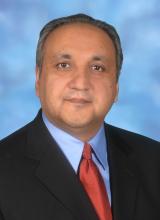Nonalcoholic steatohepatitis may soon supplant chronic hepatitis C as the leading cause of hepatocellular carcinoma among patients awaiting liver transplantation, according to the findings of a national longitudinal registry study.
The proportion of affected patients with nonalcoholic steatohepatitis (NASH) rose nearly 700% between 2002 and 2017 (P less than .0001), making NASH the only etiology to significantly rise in prevalence, reported Zobair Younossi, MD, MPH, of Inova Health System in Falls Church, Va., and his associates. Chronic hepatitis C remained the most common cause of liver cancer during the study period, but its prevalence fell by more than 10% in the last 3 years (2014-2017). These trends reflect the advent of “new, highly effective antiviral regimens” for hepatitis C, the global epidemic of obesity and metabolic syndrome, and the urgent need for effective, safe treatments for NASH, they wrote in Clinical Gastroenterology and Hepatology.
Historically, hepatocellular carcinoma is usually caused by chronic hepatitis C or B infection, but the global rise of obesity and type 2 diabetes mellitus has led to epidemic levels of NASH, a progressive form of nonalcoholic fatty liver disease that lacks useful predictive noninvasive biomarkers or safe treatments. This phenomenon, coupled with the advent of new, often-curative treatments for viral hepatitis, is making NASH a leading driver of both fibrosis and liver transplantation in the United States. To compare trends in liver cancer etiologies among transplant candidates, Dr. Younossi and his associates analyzed data on 158,347 adults who were wait-listed between 2002 and 2017 and captured by the national Scientific Registry of Transplant Recipients.
A total of 26,121 (16.5%) patients awaiting liver transplant had hepatocellular carcinoma. This proportion nearly quadrupled over the study period, from 6% to 23% (P less than .0001) and rose significantly (P less than .0001) for all liver cancer etiologies (hepatitis C and B, alcoholic liver disease, and NASH). However, the absolute rise in prevalence was far greater for NASH (1050%) than for chronic hepatitis C (more than 500%) or any other etiology.
Furthermore, while most (65%) liver cancer cases involved chronic hepatitis C, the proportion of cases involving NASH rose from 2% in 2002 to 18% in 2017 (P less than .0001). By 2017, NASH topped alcoholic liver disease, comorbid hepatitis C with alcoholic liver disease, and chronic hepatitis B as an etiology of hepatocellular carcinoma among patients listed for transplant. Conversely, by 2017, less than 50% of liver cancers were caused by hepatitis C – a more than 10% drop from 2014. Over the study period, NASH was the only etiology whose prevalence significantly increased among transplant-listed patients with hepatocellular carcinoma.
In this study, etiology of liver cancer did not seem to affect the likelihood of either death or transplantation. However, serious cardiovascular disease or late-stage cancer diagnosis might exclude many NASH patients from transplantation, the researchers wrote. “Thus, the population reported here actually may underestimate the true proportion of hepatocellular carcinoma cases related to nonalcoholic fatty liver disease and NASH in the United States. Because NASH is on a trajectory to become the most common cause of hepatocellular carcinoma in the United States, effective prevention strategies and treatment options are urgently needed for this currently underserved patient population.”
Minneapolis Medical Research Foundation is the contractor for the registry and supplied the data. Dr. Younossi reported ties to Bristol-Myers Squibb, Gilead Sciences, AbbVie, Intercept Pharmaceuticals, and GlaxoSmithKline.
SOURCE: Younossi Z et al. Clin Gastroenterol Hepatol. 2018 Jun 14. doi: 10.1016/j.cgh.2018.05.057.

